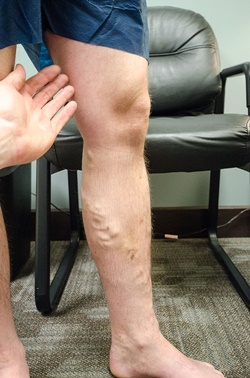 Bulging veins
Bulging veinsIf you answered yes to any of these questions, we recommend a consultation with Dr. Peter Jensen and—depending on your symptoms—to have diagnostic tests using a special diagnostic tool, Duplex ultrasound. These simple, pain-free tests can determine whether you suffer from venous reflux, a disease that commonly causes any of these symptoms.
Call us to schedule an in-office consultation. We’ll guide the way as you make the best decision for you, based on the degree of your symptoms, insurance coverage, costs, etc.
Venous reflux (also called varicose veins and venous insufficiency): a condition in which the flow of blood through the veins is inadequate, causing blood to pool in the legs. Veins have pairs of leaflet valves to prevent blood from flowing backwards (retrograde flow or venous reflux). Leg muscles pump the veins to return blood to the heart (the skeletal-muscle pump), against the effects of gravity. When veins become varicose, the leaflets of the valves no longer meet properly, and the valves do not work (valvular incompetence). This allows blood to flow backwards and they enlarge even more. Varicose veins are most common in the superficial veins of the legs, which are subject to high pressure when standing.
Without treatment, the increased pressure within the legs can progress, causing additional valve failure (causing the varicose veins to “grow up or down the leg”), skin color changes, and in the worst cases, venous ulcers.